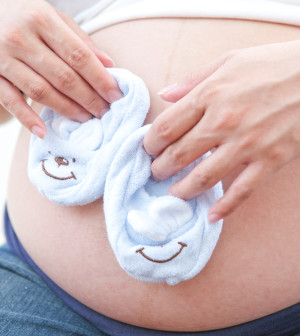- Skip Storing This Everyday Product in the Fridge Door
- Green Tea + B3 Pairing May Boost Brain Health
- Navigating Your Midlife Crisis: Embracing New Possibilities
- City Raccoons Showing Signs of Domestication
- Mapping the Exposome: Science Broadens Focus to Environmental Disease Triggers
- One Week Less on Social Media Linked to Better Mental Health
- Your Brain Changes in Stages as You Age, Study Finds
- Some Suicide Victims Show No Typical Warning Signs, Study Finds
- ByHeart Formula Faces Lawsuits After Babies Sickened With Botulism
- Switch to Vegan Diet Could Cut Your Greenhouse Gas Emissions in Half
Gel May Offer Simple Treatment for Newborns With Low Blood Sugar


THURSDAY, Sept. 26 An easy-to-use gel containing dextrose — a form of sugar — may be an effective way to treat low blood sugar levels in newborns, new research finds.
Giving infants two doses of the gel nearly halved the odds of treatment failure for low blood sugar, or hypoglycemia, compared to an inactive placebo, according to study author Jane Harding, at the University of Auckland in New Zealand, and colleagues.
“Dextrose gel should be considered for first-line treatment to manage hypoglycemia in late preterm and term babies in the first 48 hours after birth,” the researchers concluded in the study published online Sept. 25 in The Lancet.
Low blood sugar levels (hypoglycemia) can be a serious problem in newborns. It’s associated with brain injury and poor neurodevelopmental outcomes, according to study background information. Between 5 percent and 15 percent of newborns may have hypoglycemia.
The incidence of hypoglycemia appears to be on the rise, the researchers noted. And, they suspect that the increase in maternal obesity and diabetes may be part of the reason.
Dr. Deborah Campbell, director of the division of neonatology at the Children’s Hospital at Montefiore in New York City, said three main reasons explain why certain groups of babies may be hypoglycemic soon after birth.
For babies born to mothers with diabetes, especially uncontrolled diabetes, the mother’s high blood sugar levels cause the baby’s body to pump out more insulin — a hormone that helps lower blood sugar — in response. After birth, all the extra insulin can make the baby’s blood sugar levels drop. Because the baby may have been living in a high-blood sugar environment, their bodies may not compensate as well as they otherwise might have, Campbell said.
The second group at risk includes babies who are premature and growth-restricted, known as small for gestational age. “These babies don’t have significant stores of glycogen (a natural form of sugar in the body). They have lower glycogen stores and less nutrients available, so they very quickly deplete what they have in terms of stored glycogen. But, within 24 hours or so, they can usually stabilize,” Campbell noted.
The third group is sick babies, because the stress of illness can speed up the metabolism as the body tries to deal with the illness.
For the current study, the researchers randomly assigned 237 babies who had hypoglycemia to receive either treatment with a 40 percent dextrose gel placed between the cheeks and gums or a placebo. The dextrose dose was based on the baby’s body weight. The babies received up to six doses over 48 hours.
All of the babies were born at a single center in New Zealand between 2008 and 2010, at 35 weeks’ gestation or higher.
Just 14 percent of babies on the gel experienced treatment failure — a low blood sugar level after two doses — while 24 percent of the placebo group had treatment failure. Babies given the gel were less likely to be admitted to intensive care for hypoglycemia, and less likely to be given supplemental formula feeds.
The study authors estimate this intervention would cost about $2 per baby.
“In a resource-poor environment, this is an outstanding tool,” said Dr. Richard Schanler, director of neonatal services at North Shore-LIJ Health System in New Hyde Park, N.Y. He was not involved with the study.
However, both he and Campbell were unsure if such a treatment would catch on in the United States. Schanler said that currently, if a baby is hypoglycemic, the baby is given a feeding — either breast or formula — to raise the blood sugar. Blood sugar is then checked again at 30 minutes, and if it’s still low, the baby is given another feeding. If blood sugar levels don’t rise, a baby may need intravenous glucose and that type of care generally occurs in a neonatal intensive care unit (NICU), he explained.
But, he added, “A little bit of feeding is usually enough to get the blood sugar to rise.”
Schanler said his biggest concern with not sending a baby with sustained hypoglycemia to the NICU is that it might be harder to quickly identify a baby with an underlying abnormality or illness.
“On the one hand it seems like a great, inexpensive idea, but it would have to be adopted with caution and additional training of personnel,” Schanler said.
“This is something to be thoughtful about,” Montefiore’s Campbell noted, “but it definitely needs more study. But, if you can find something that works as well as IV glucose for kids who are otherwise healthy and born over 35 weeks’ gestation, it could save a lot of money,” she added.
“But, dextrose gel doesn’t work for every baby. We would need to dissect the findings of this and other studies to find out which babies would benefit most,” Campbell said.
More information
Learn more about gestational diabetes, which can lead to low blood sugar in babies, from the American Diabetes Association.
Source: HealthDay
Copyright © 2025 HealthDay. All rights reserved.










